MANDALAY & ENVIRONS
Mandalay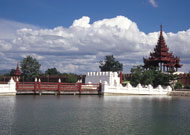 Mandalay was the last capital of the third Myanmar Empire. It
is located 668 km north from Yangon. Mandalay's value lies in
that it is a repository of late Myanmar history. Mandalay
embodies all the elements of Myanmar's ancient educational,
social and cultural system. Mandalay is the home and guardian
of the best traditions of Myanmar music and dance .The
Mandalayans preserves the proper spoken language of Myanmar.
Symbols of religion are richer in Mandalay than in any of the
living Myanmar city. It is the principal centre for studies of
Buddhist literature. The other tourist attractions are
Mandalay Hill, Mya-nan-san-kyaw Golden Palace, the old city
walls and the moat, Mahamuni Image of Buddha, Kyauk-taw-gyi
(White Marble) Buddha and Kuthodaw Pagoda with the entire
Buddhist scriptures inscribed on 729 marble slabs, known as
the "World's Biggest Book".
Mandalay was the last capital of the third Myanmar Empire. It
is located 668 km north from Yangon. Mandalay's value lies in
that it is a repository of late Myanmar history. Mandalay
embodies all the elements of Myanmar's ancient educational,
social and cultural system. Mandalay is the home and guardian
of the best traditions of Myanmar music and dance .The
Mandalayans preserves the proper spoken language of Myanmar.
Symbols of religion are richer in Mandalay than in any of the
living Myanmar city. It is the principal centre for studies of
Buddhist literature. The other tourist attractions are
Mandalay Hill, Mya-nan-san-kyaw Golden Palace, the old city
walls and the moat, Mahamuni Image of Buddha, Kyauk-taw-gyi
(White Marble) Buddha and Kuthodaw Pagoda with the entire
Buddhist scriptures inscribed on 729 marble slabs, known as
the "World's Biggest Book".
One account states that during the reign of King Mindon,
steamers began to come up to INNWA (AVA) and AMARAPURA. Since
both towns were on the bank of the AYEYARWADDY (IRRAWADDY)
RIVER, it would have been possible for the Europeans to bring
artillery pieces up-river aboard the trading ships and to
shell the then capital of AMARAPURA. King Mindon therefore
decided that the capital should be moved some distance from
the river, beyond the range of enemy fire. This must have been
the original reason of founding MANDALAY though there were
some other reasons.
HIGHLIGHTS
Mandalay Hill
 MANDALAY HILL is
a top priority for all who come here. Apart from its Pagoda
and buildings, it is the best place to enjoy the sunset.
Visitors are seen hurrying up the hill to get a panoramic view
of the sun going down majestically behind the mountain.
Pagodas and shrines on the mountain and hues and rays of the
setting sun reflecting in the Great RIVER AYEYARWADDY will
make it a memorable event for life. The best hours to climb up
the hill - just to avoid the midday heat - are before 10am or
after 4pm. MANDALAY HILL is
a top priority for all who come here. Apart from its Pagoda
and buildings, it is the best place to enjoy the sunset.
Visitors are seen hurrying up the hill to get a panoramic view
of the sun going down majestically behind the mountain.
Pagodas and shrines on the mountain and hues and rays of the
setting sun reflecting in the Great RIVER AYEYARWADDY will
make it a memorable event for life. The best hours to climb up
the hill - just to avoid the midday heat - are before 10am or
after 4pm.
Royal Palace
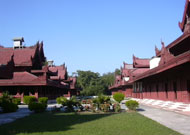 It was founded by King Mindon who was the second last of
Myanmar King in 1861. The original mote and walls 2km long on
each side still majestically stand with splendid spires over
each gate. Unfortunately, it was bombed out and destroyed by
the air-raid of allied forces during world war II. But it has
now been renovated to give an air of the awesome scale of the
Myanmar's works of art and served as a museum. Apart from the
renovated works of the complete grounds, the wall and its
pavilions are original. It was founded by King Mindon who was the second last of
Myanmar King in 1861. The original mote and walls 2km long on
each side still majestically stand with splendid spires over
each gate. Unfortunately, it was bombed out and destroyed by
the air-raid of allied forces during world war II. But it has
now been renovated to give an air of the awesome scale of the
Myanmar's works of art and served as a museum. Apart from the
renovated works of the complete grounds, the wall and its
pavilions are original.
Maha Muni Pagoda
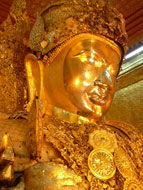 Probably the greatest Pagoda in Mandalay. In fact, the
image inside the pagoda, transported to the present site from
Mrauk U in Rakhine State in 1784, is the most revered by the
Buddhist devotees all over the country. This originally bronze
image is glittering in gold due to its gold leafs gilded by
countless thousands of devotees over many generations. The
image is about 4 meter high and the pagoda is always crowded
with pilgrims far and near. One of the events worth to see is
its early morning ritual of washing and brushing of The
Image's face and Teeth by a team of monks. Probably the greatest Pagoda in Mandalay. In fact, the
image inside the pagoda, transported to the present site from
Mrauk U in Rakhine State in 1784, is the most revered by the
Buddhist devotees all over the country. This originally bronze
image is glittering in gold due to its gold leafs gilded by
countless thousands of devotees over many generations. The
image is about 4 meter high and the pagoda is always crowded
with pilgrims far and near. One of the events worth to see is
its early morning ritual of washing and brushing of The
Image's face and Teeth by a team of monks.Shwe Nandaw
or Golden Palace Monastery
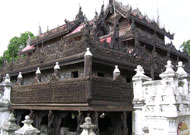 It is originally an apartment from the palace complex
where King Mindon and his chief queen spent most of their
happy married life. It was in this building that King Mindon
breathed his last, after a prolonged illness. After his death,
his successor, King Thibaw, because of the associations and
memories the apartment carried, decided to get transplanted
bodily here and housed a monastery in it in order that merit
may accrue to his predecessor. It is said that King Thibaw
used the building for meditation, and the couch on which he
sat can still be seen. It now serves as a museum where you can
observe and marvel the wonderful woodcarvings of that era
(mid-nineteenth century). It is originally an apartment from the palace complex
where King Mindon and his chief queen spent most of their
happy married life. It was in this building that King Mindon
breathed his last, after a prolonged illness. After his death,
his successor, King Thibaw, because of the associations and
memories the apartment carried, decided to get transplanted
bodily here and housed a monastery in it in order that merit
may accrue to his predecessor. It is said that King Thibaw
used the building for meditation, and the couch on which he
sat can still be seen. It now serves as a museum where you can
observe and marvel the wonderful woodcarvings of that era
(mid-nineteenth century).Sandamuni Pagoda:
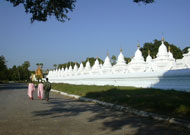 Located at the southwest of Mandalay Hill, this complex of
cluster whitewashed Stupas was built over the site of King
Mindon's temporary palace. In addition, this is the spot where
the King's younger brother, Prince Kanaung had been
assassinated, and to commemorate this sad event, this Stupa
was built. Around the main Stupa, you can see a large
collection of marble slabs inscribed with commentaries on the
Buddhist scriptures. Located at the southwest of Mandalay Hill, this complex of
cluster whitewashed Stupas was built over the site of King
Mindon's temporary palace. In addition, this is the spot where
the King's younger brother, Prince Kanaung had been
assassinated, and to commemorate this sad event, this Stupa
was built. Around the main Stupa, you can see a large
collection of marble slabs inscribed with commentaries on the
Buddhist scriptures. Kuthodaw Pagoda
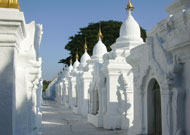 Located at the foot of the Mandalay hill and its white
small shrines house for 729 marble slabs inscribed with the
whole doctrines of Buddha. It is said that it would take more
than a year for one – if reading for eight hours a day - to
read all these texts and thus known as the World's Biggest
Book. During the Fifth Buddhist Synod, it took a team of 2400
monks nearly six months to read the whole scriptures in a
nonstop relay! When all these stone scriptures had been
printed out and published in 1900, it turned out to be a book
form in about 30 volumes, each with about 400 pages. Located at the foot of the Mandalay hill and its white
small shrines house for 729 marble slabs inscribed with the
whole doctrines of Buddha. It is said that it would take more
than a year for one – if reading for eight hours a day - to
read all these texts and thus known as the World's Biggest
Book. During the Fifth Buddhist Synod, it took a team of 2400
monks nearly six months to read the whole scriptures in a
nonstop relay! When all these stone scriptures had been
printed out and published in 1900, it turned out to be a book
form in about 30 volumes, each with about 400 pages.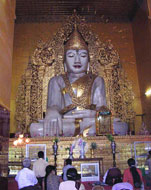 Kyauktawgyi Pagoda Though originally plan to be modeled after the
Ananda Temple of Bagan, this great scheme failed to carry out
due to a palace rebellion. The centerpiece of this Pagoda is
the huge seated Buddha Image carved out of single marble block
of marble just as the Abaya Labamuni Buddha Image in Yangon
but smaller. The marble block was so huge that it required
10,000 men for 13 days to transport it from the nearby Sagyin
<Marble> mine to the present site. Its annual festival,
usually falls in October, is the one of the busiest ones in
Mandalay.
OTHER INTERESTING SITESZegyo MarketThe old market designed by an Italian Count Caldari in 1903
was transformed into four storey new buildings on 84th St
between 26th & 27th Sts, represents the central market of
Mandalay. Here is the place where you can have the largest
selection of locally and foreign stuffs.Night Market Appeared around the 84th and 27th Sts in
evening, it is the place where you can wander around among the
several stalls selling miscellaneous stuff as well as famous
Mandalay eatables.Yadanapon Zoological Garden
Located in front of northern side of Palace, it is a quiet
spot to have a stroll while observing the fair selection of
animals.Yankin HillSituated about 3km eastwards of Mandalay
Palace, it is another good spot to enjoy the sunset.Judson Baptist Church
Founded by the famous American missionary Father Judson
who had been in Myanmar in 1813, this church stands on 82nd St
between 33rd & 34th Sts. Father Lafon's Catholic Church Located on the west side of 80th St between 34th & 35th, this
gothic style church was built by the French Fathers in 1894,
and the normal routine of the church including daily mass is
still maintained.Sacred Heart Cathedral
Originally built in 1873, this church was bombed out
during WW II and rebuilt in 1951. Located on the east side of
82nd St between 25th & 26th Sts. Daily mass is also available
here.Mandalay Marionettes Theatre
As Mandalay is the cultural heart of Myanmar, there are
several entertainment scenes perform at important occasions
like Pagoda festivals, weddings and novitiation ceremonies.
For those who want to sample Myanma Marionettes, go and
check out one of these places: Mandalay Marionettes Theatre
– on 66th St., between 26th & 27th Sts or Pyigyimon Floating
Restaurant. Both perform marionette shows with music and
dancing nightly.
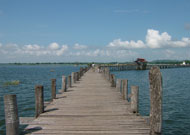 Amarapura (literally meaning 'the immortal city') lies
about 11 km south of Mandalay. The modern town of AMARAPURA is
often referred to as TAUNG MYO, meaning "The Southern City" to
distinguish it from MANDALAY, the Northern City. The famous U
Pein Bridge, built with teak posts spans Taungthaman Lake. It
measures 1208 meters and probably is the longest bridge of its
kind in South East Asia. Other places of interest include
Pahtodawgyi Pagoda, Kyauktawgyi Pagoda and Mahagandayon
Monastery. Amarapura (literally meaning 'the immortal city') lies
about 11 km south of Mandalay. The modern town of AMARAPURA is
often referred to as TAUNG MYO, meaning "The Southern City" to
distinguish it from MANDALAY, the Northern City. The famous U
Pein Bridge, built with teak posts spans Taungthaman Lake. It
measures 1208 meters and probably is the longest bridge of its
kind in South East Asia. Other places of interest include
Pahtodawgyi Pagoda, Kyauktawgyi Pagoda and Mahagandayon
Monastery.
A former capital situated only 30-minute drive south of
MANDALAY. At one time Myanmar was known in the west as the
KINGDOM OF AVA. Though the Royal Palace has gone, the Pagodas,
Temples and Monasteries still remain. Of particular interest
are the brick monastery called MAHA AUNG MYAY BONZAN, built by
Queen Me Nu and NANMYINT watchtower, which gives a birds' eye
view of the ancient site.
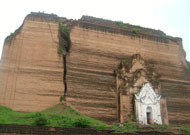 About 11 km trip up-river from MANDALAY on the opposite bank
of the AYEYARWADDY River is the pleasant and peaceful MINGUN
VILLAGE. This 45 minute memorable journey gives visitors a
fascinating experience of life along the river. It is home to
the 90 tons weigh World's Biggest RINGING Bell as well as the
World's Largest but Unfinished Pagoda. History has it that if
King Bodaw Phaya had succeeded in his great plan; this Pagoda
might now have been the World's Largest Pagoda. Unfortunately,
Bodaw Phaya died before the construction was completed. About 11 km trip up-river from MANDALAY on the opposite bank
of the AYEYARWADDY River is the pleasant and peaceful MINGUN
VILLAGE. This 45 minute memorable journey gives visitors a
fascinating experience of life along the river. It is home to
the 90 tons weigh World's Biggest RINGING Bell as well as the
World's Largest but Unfinished Pagoda. History has it that if
King Bodaw Phaya had succeeded in his great plan; this Pagoda
might now have been the World's Largest Pagoda. Unfortunately,
Bodaw Phaya died before the construction was completed.
Located at 21 km southwest of Mandalay, Sagaing hill is Dotted
with pagodas and over 600 monasteries and nunneries. Most date
from the turn of 19 century and are built in a fascinating mix
of colonial and old Myanmar style. Nowadays, the Sagaing Hills
is noted as a religious retreat for Myanmar Buddhist devotees.
About 10 km north from Sagaing stands Kaungmudaw, an enormous
dome-shaped pagoda built by King Thalun in 1636. Nearby lies
Ywahtaung village, which is well known for its silver
craftsmanship.
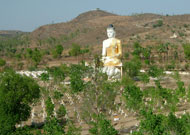 Situated some 136 km northwest of MANDALAY, MONYWA is the
center of the CHINDWIN VALLEY. Being the second largest river
of Myanmar, CHINDWIN is important for trading in the area.
History has it that MONYWA was founded in the BAGAN Era
(1044-1287) and it was formerly called "THALARWADDY". It is
noted for its unusually Temples. One of the most famous is
THANBODDHAY TEMPLE, which resembles INDONESIA'S BOROBUDUR
because of similarities in its architectural design. KYAUKKA
VILLAGE, some 16 km east of MONYWA, is also famous for its
lacquer ware cottage industry. Its lacquer ware goods are
comparable with Bagan's wares in quality. Another highlight of
MONYWA is the crater lake of TWIN HILLS. According to
geologists, it was the crater of an extinct volcano some five
million years ago. But another version said that it was the
effect of a meteorite, and rainfall subsequently filled the
crater to form a lake. Situated some 136 km northwest of MANDALAY, MONYWA is the
center of the CHINDWIN VALLEY. Being the second largest river
of Myanmar, CHINDWIN is important for trading in the area.
History has it that MONYWA was founded in the BAGAN Era
(1044-1287) and it was formerly called "THALARWADDY". It is
noted for its unusually Temples. One of the most famous is
THANBODDHAY TEMPLE, which resembles INDONESIA'S BOROBUDUR
because of similarities in its architectural design. KYAUKKA
VILLAGE, some 16 km east of MONYWA, is also famous for its
lacquer ware cottage industry. Its lacquer ware goods are
comparable with Bagan's wares in quality. Another highlight of
MONYWA is the crater lake of TWIN HILLS. According to
geologists, it was the crater of an extinct volcano some five
million years ago. But another version said that it was the
effect of a meteorite, and rainfall subsequently filled the
crater to form a lake.
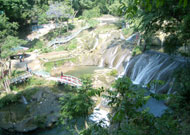 PYIN OO LWIN (formerly called MAYMYO) is the one of the most
famous hill station cities of Myanmar. Its fine, pleasant
weather and fresh cool air makes it a popular summer resort.
It enjoys another name given affectionately by the local – PAN
MYO DAW, or Royal Flower City due to its variety of colourful
flowers growing in abundance all over the town. This beautiful
resort is situated only 70 km away from MANDALAY. Dotted
around the town are half-timbered Tudor style cottages
surrounded by well-kept gardens. Since the place is full of
visitors all year round several of these cottages have now
been converted into hotels. Some of the highlights are the PWE
KAUK or B.E. Waterfall, the DAT TAW GYAIK Waterfall, the
famous Botanical Garden and the Chinese Temple. Being rich in
natural scenic spots, PYIN OO LWIN is the favourite place for
nature lovers, photographers, artists, and moviemakers.
Besides, it is also junction leading to the China border towns
of LASHIO and MUSE. PYIN OO LWIN (formerly called MAYMYO) is the one of the most
famous hill station cities of Myanmar. Its fine, pleasant
weather and fresh cool air makes it a popular summer resort.
It enjoys another name given affectionately by the local – PAN
MYO DAW, or Royal Flower City due to its variety of colourful
flowers growing in abundance all over the town. This beautiful
resort is situated only 70 km away from MANDALAY. Dotted
around the town are half-timbered Tudor style cottages
surrounded by well-kept gardens. Since the place is full of
visitors all year round several of these cottages have now
been converted into hotels. Some of the highlights are the PWE
KAUK or B.E. Waterfall, the DAT TAW GYAIK Waterfall, the
famous Botanical Garden and the Chinese Temple. Being rich in
natural scenic spots, PYIN OO LWIN is the favourite place for
nature lovers, photographers, artists, and moviemakers.
Besides, it is also junction leading to the China border towns
of LASHIO and MUSE.
Thibaw is a small, peaceful and relaxed town situated between
Mandalay and Lashio. Its residents are mostly Shan and the
town itself is rather unsophisticated and enjoys moderate
climate. Thibaw is small enough to roam about on foot, and
most of the travelers who are not in a hurry like to its
simple and ambience atmosphere. As the place is gradually
popular amongst the foreign traveler, the number of lodgings
are increased as well.
It is located on Mandalay ~ Muse road and about 200 km far
from China border. Nowadays the town is getting more and more
occupied by many a Chinese and thus you can easily see Chinese
influence in town. There are some pagodas and a hot spa for a
foreign traveler to visit. But the railroad to Mandalay is
quite fascinating since the train passes over the GOKHTEIK
viaduct which is said to be the world's second largest steel
bridge of more than a hundred years old.
NORTHERN MYANMAR
Bhamo has been a trading centre on Myanmar ~ China border for
many generations. The interesting site to roam about is Bhamo
market busied with all sorts of local and Chinese products.
The river-cruise down to Mandalay will be full of exciting
passing through the Ayeyarwaddy' s famous defiles, and it is
rather recommend to adventurers.
It is a rail-terminal of further north of Mandalay. Myitkyina
is the capital of Kachin State and majority embrace the
Christianity. Generally townspeople are warm and friendly and
able to speak English well. The town was a battle field during
world war II.
Puta-O is another town in Kachin State surrounded by
snow-peaked mountains. It is cool the whole year round and
there are many varieties of citrus fruits grown in the
orchards. It is the nearest town to the base camp for
Climbing Mt. Khakhaborazi (5889 metres), which is the
highest mountain in Myanmar and in Southeast Asia. |